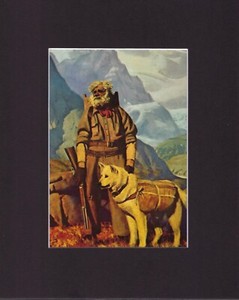
Last Frontier Tales
Overnight Success? Not Hardly
By Hank Nuwer
“Overnight success” for Alaska artist Fred Machetanz and his author wife Sara took a “mere” 15 years of struggle and penny-pinching.
Ever after Fred’s 1962 one-artist show at an Anchorage hotel, art dealers and buyers clamored to purchase his work. Often, they had to wait. Fred was a slow, careful artist, and he completed fewer treasures for sale than did many of his fellow artists.
The hotel exhibit earned him $10,000. The couple used a portion of the money to build a gravel road leading to their then-remote log cabin in Palmer.
Sara’s writing also found a fan base about then. For a time, she sold her nonfiction books and her books for children packed with Fred’s illustrations. Eventually, she put down her pen to handle her husband’s business and personal affairs. His growing popularity brought awards, requests to speak, and media interview opportunities.
Fred partnered with Anchorage’s Antique Gallery and signed a contract for illustrated coffee-table books of his work with Mill Pond Press.
The down side of success was that these commitments kept him from his easel and palette.
Before the big breakthrough, from their 1947 marriage until 1962, he and Sara had scant time to work on serious projects. They had to take on never-ending freelance projects and his illustrations.
One exception was a year’s grace when art patrons Elmer Rasmuson and Anchorage newspaper publisher Bob Atwoood gifted him a grubstake to stay in their Palmer cabin and paint.
What never changed as Fred gained renown was his passion for Alaska’s land and its people.
“I paint the romantic Alaska, the Alaska before World War Two,” Fred told an Anchorage Daily News (ADN) reporter. “I’m painting the north country the way it was in those years.”
One of his declared inspirations was Western artist Frederic Remington.
Remington’s images preserved the bygone Old West on canvas and in sculpture.
In addition to landscapes of Alaska’s glaciers, majestic mountains and iced-over coastal ranges, Fred painted on hardboard the animals and rugged people of a bygone era: polar bears, grizzlies, sourdough prospectors, Eskimos and native peoples, sled dogs, and whale harpooners.
“He started with a particular vision of Alaska, and he hasn’t watered it down,” Ken Woodward, a University of Alaska Fairbanks art professor told the ADN in 1994. Fred, by then, taught art students himself at UAA.
All the rest of his life, recognitions of Fred’s genius came his way.
The Alaska Hall of Fame enshrined him in 1966. American Artist magazine dubbed him the 1981 artist of the year and splashed his work inside and on the cover. Ohio State University awarded him an honorary doctorate in 1984 to go with his earned undergraduate and graduate degrees. Later, the University of Alaska also gave him an honorary doctorate.
Throughout the slim times and thick, Fred and Sara enjoyed the good life. Their cabin became an artistic salon for their friends who loved art as much as the couple did. Fred’s High Ridge bar was always piled high with limes to decorate the pitchers of margaritas he loved to serve, recalled his buddy William J. Tobin, an Anchorage editor.
Finally, as in life, the couple died but one year of each other.
Sara Machetanz died at home on September 20, 2001. She was 83
Fred’s passing came October 6, 2002. He was 94.
Perhaps the best way to end this column is with an excerpt from a critique of Fred’s work written by visiting French art critic Marie Schnir in 1971.
“The art of Fred Machetanz is part of his closeness to Alaska,” wrote Schnir. “It expresses how near the country is to men. Here generations have gone, the mines cease to give gold, traditions are passing, planes replace rail, but what is staying depends only on man.
“To feel it you must live in this white silence, make a fire with pieces of wood fallen to the ground, to make yourself one with the work. The works of Machetanz are treasured moments of pleasure, face to face with this nature where the human being knows how limited he is—it is a reminder.”
Hank Nuwer is an adjunct professor at the University of Alaska Fairbanks. On October 24, he begins a three-week run playing the wily chief inspector in the Fairbanks Drama Association’s Dial “M” for Murder.